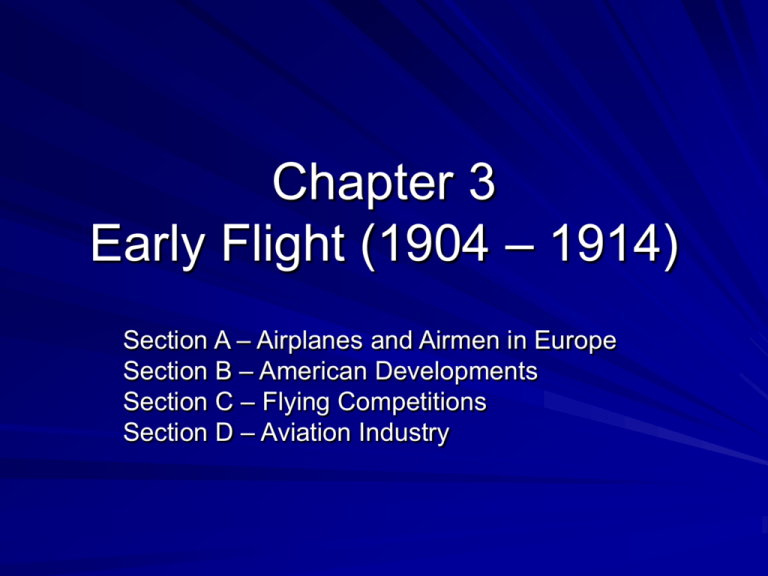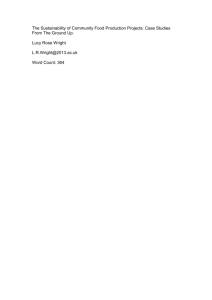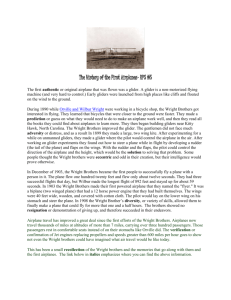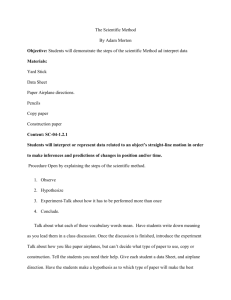Early Flight (1904-1914): Airplanes & Airmen
advertisement

Chapter 3 Early Flight (1904 – 1914) Section A – Airplanes and Airmen in Europe Section B – American Developments Section C – Flying Competitions Section D – Aviation Industry Section A Airplanes and Airmen in Europe The Wright brother had achieve powered flight in 1903 and demonstrated its practicality, but were reluctant to share their technology. Despite, the brothers’ refusal to cooperate with other inventors, development work in aviation continued without the Wright’s technology and without detail knowledge of the technology. Octave Chanute helped to inspire some of the European efforts by lecturing in Paris in 1903 on his and the brothers’ gliders. He talked about wing warping and the use of the rear rudder. He spurred the pride of the French. European Developments Robert Esnault-Pelterie – Tried to reproduce the 1902 Wright glider Reproduction included wing warping – Without the Wright’s Technology and knowledge, he failed. – In 1904 Pelterie devised his own glide, it flew in October Used ailerons in front instead of wing warping. European Developments In 1905, Gabriel Voisin and attorney Ernast Archdeacon organized the Syndicat d’Aviation, the first company organized to make heavierthan-air craft. The company produced two gliders, one for Archdeacon and one for engineer Louis Bleroit. Both gliders flew successfully; Bleriot-Voisin Company was born., but the broke up in 1906. That same year Voisin established his own factory With Bleriot, he built a biplane with a little Antoinette motor, used for boats. European Developments France was on it’s way in aviation, but other countries were making developments in airplane too. Trajan Vuia – Romanian aviator, who called his monoplane ‘No. 1’ – His aircraft featured variable wing incidence and pneumatic tires. Incidence- the angle between the airplane’s longitudinal axis and the wing’s chord line. Chord line- the imaginary line from the leading edge of an airfoil to the trailing edge. First Airplane Flight in Europe Alberto Santos-Dumont Brazilian aviation pioneer living in Paris. – Turned attention from dirigibles to airplanes. – Designed a biplane he called ‘14-bis’ and hired Gabriel Voisin to build the plane – 50-hp Antoinette engine – Won the Archdeacon Prize for the first flight of 25 meters. – November 12, 1906- first official recognized airplane flight in Europe. Production Production began by the Voisin Freres. – Influenced by the Wright brothers, they developed a pusher biplane with a forward elevator and tail rudder. – They produced about 20 planes by 1914, WWI. – Most European aircraft makers were influenced by Wilbur’s European Tour in 1908. Henry Farman Ordered a plane from Voisin and made improvements to it by modifying the tail and adding ailerons. – The plane was Europe’s first flight around a circular route in 1908 and won the Grand Prix D’Aviation. Started his own airplane production company after he ordered a second plane and Voisin sold it to someone else. 1909 Rheims International Air Meet, he became the first pilot to fly more than 100 mile (111.8 miles) and was top prize winner at the air meet. Short Brothers Horace, Albert, and Hugh Short – Established an airplane manufacturing company in Great Britain in 1908. – Obtained a license from the Wright brother’s to build six Wright airplanes the next year. The first in the world to produce airplanes in a series. Louis Bleriot Built the Bleriot XI (1909), became the first airplane to fly across the English Channel, after ditching the first attempt. Flew across the E.C. for the prize money and to promote his company. – Wilbur Wright considered the feat, but decided not due to the risk involved, plus he need his plane for continued marketing. He crashed in Romania in December of 1909, his 32nd crash, where he was seriously injured was eventually stopped flying. Igor I. Sikorsky Believed that a flying machine could be lifted not by wings, but by propeller. – Back in Russia, he built a helicopter, but it failed. He figured that he should learned to fly first. – He built the S-1, but it lacked horsepower, – but the S-2 flew and he taught himself to fly. The S-5 was controlled by pedals for the rudder and by a single wheel instead of two sticks from the elevator and ailerons. 1911, qualified for a pilot’s license, number 64. German Airplanes Germany entered aviation a bit later than the U.S., France, and Great Britain, but obtained licenses to bulid foreign airplanes Established about 25 production complanies before WWI. End of Section A Section B American Developments The Wright brothers were number one in American aviation, but they were not alone. They lead American aviation through 1908 and even 1909, but they increasingly faced competition. Competitors challenged the Wrights in technological matters, commercial sales, and popular opinion. Aerial Experiment Association AEA – Founded and led by Alexander Graham Bell Purpose was to build a practical airplane. Members included: – – – – J.A.D. McCurdy of Canada Lt. Thomas Selfridge, US Army Thomas Baldwin (dirigibles) Glenn Curtiss (Bike and motorcycle maker) Most notable was the development and patent for their wingtip aileron. Curtiss continued the aileron legacy in his aircraft manufacturing company Curtiss Airplanes First Manufactured pusher airplanes with ailerons – The ailerons were placed midway between the wings Brought on a legal battle with the Wright Bros. He tried to get orders from the US Navy – He designed hydroplanes and flying boats Landplanes with floats in place of wheels, usually only one float – Flying boat went under testing Jan. 1912 at San Diego, California. Exhibition and Stunt Flying Curtiss decided to form an exhibition team – Two pilots and two planes Curtiss performed stunts, pilots did not Earned Commission, earned 50% of take The Wright Bros. – The Wright Fliers Exhibition Team Earned Salaries Earned less money End of Section B Time to take a break!!!








